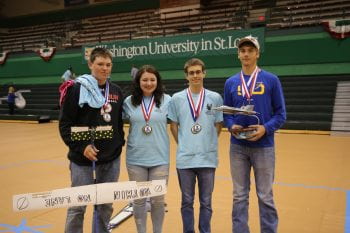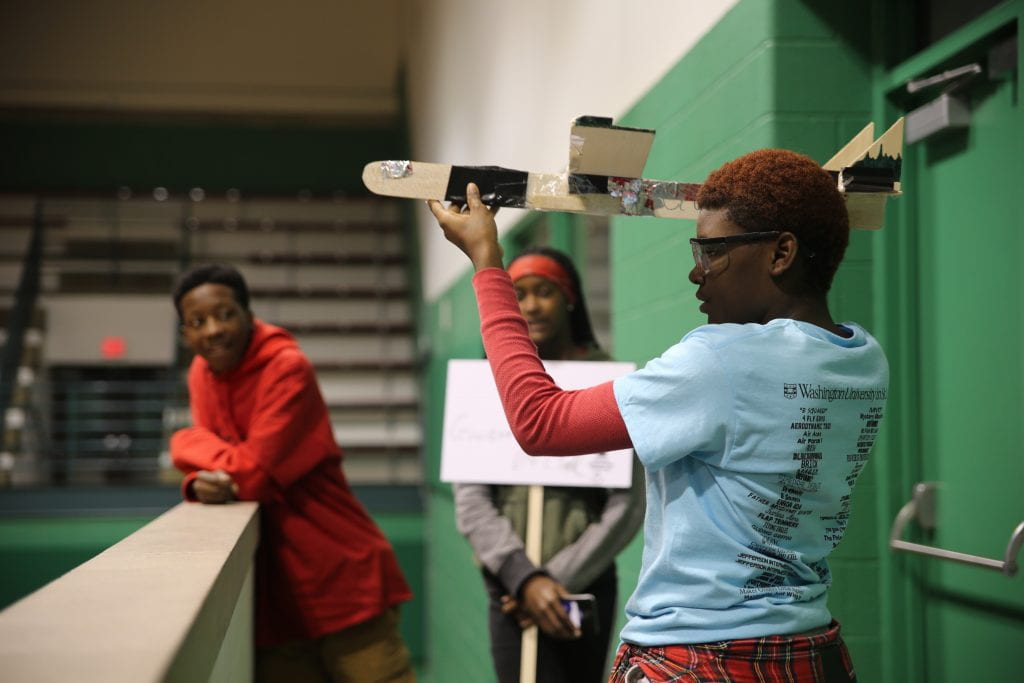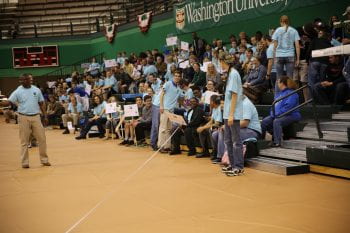“We’ve got a lot of bragging rights,” a jubilant Zack Hurley said.
The senior from Calhoun High School in Hardin, Illinois, was part of a quartet that went the distance at the final flight of the Boeing Engineering Design Challenge, held May 3 in the Washington University Field House.
Their glider, dubbed No Pain, No Lane, won Division 1 overall, as well as longest ground distance, gliding the length of the field house and clocking in at 142 feet.
Seventy teams of nearly 240 students from dozens of public and private schools across the St. Louis metro region gathered to test their might. The program, now in its ninth year, challenges students to design and construct a glider out of balsa wood with the help of supplies and a mentor provided by The Boeing Company. However, the challenge goes far beyond simply building a glider. Over the course of six months, the gliders undergo design and technical readiness reviews, and the students must give a presentation of their design before a panel of Boeing engineers.

The No Pain, No Lane team were first timers, but very confident heading into the contest. They’d had great practice flights, and in fact, were so sure in their design they declined advice from mentors.
“Our motto the whole year was add more weight, even though teachers told us that’s not what we should do,” chuckled Blake Schuman, a junior at Calhoun High School. “We said, ‘No! We’re adding more weight.”
The front of their glider carried 50 grams, which is normally heavy, but in their case, was just the right amount to make it balanced and fly straight.
Pamela Petterchak and Nicole Wagoner were hoping the third time was the charm for them. Both acknowledged pervious years had been difficult.
With a positive mindset, the juniors from Affton High School in St. Louis County, dubbed their glider Trial and Lots of Error.
They were pumped after their first flight made a decent showing.
“This is our first glider that’s done really well!” Wagoner said. “This year we went simple. In past year’s we always tried to do something different or so something unique with our design and it always made it more complicated than it needed to be. This year we went simple and it’s been working out really well for us.”
“It went more distance than we thought, so we did good,” she said.
Marissa Cooper, a ninth-grader from Jennings High School was nervous and scared coming into the competition for the first time, but said it was a lot of fun. Their team glider was called – Guerrier du Ciel which translated from French means Warrior of Heaven.
“It was cool,” said her teammate Toby Wisham. “I thought we weren’t going to do well, but we did quite decent.
Fellow teammate Jalann Reeves had a blast and can’t wait to do it again. He describes their mindset heading into the competition.
“I felt that we should come out, have fun and do our best. I was really looking forward to this.”
Boeing sponsors the competition with support from Washington University’s Alumni & Development Office, the Institute for School Partnership and the School of Engineering & Applied Science.
Matt Daniels, senior manager of education relations at Boeing, said the design challenge is one of the many ways Boeing supports students in the region by offering hands-on learning experiences and STEM mentoring.
“Boeing is committed to helping students develop 21st century skills needed to succeed in academics and in life. We know these students represent our future and we complement their learning experiences with real-world applications like the Boeing Engineering Challenge,” Daniels said.
May 2017 | by, Myra Lopez

